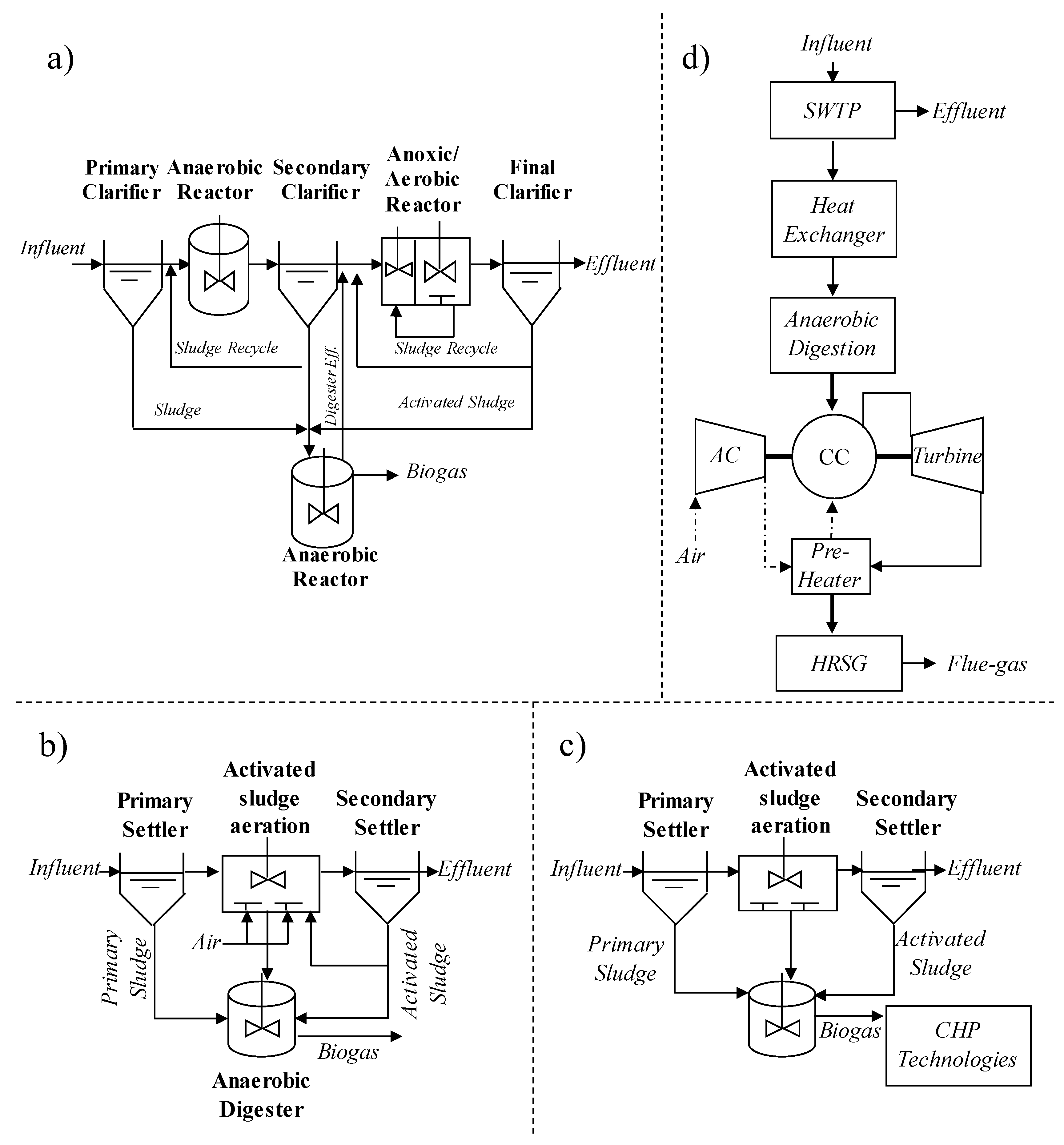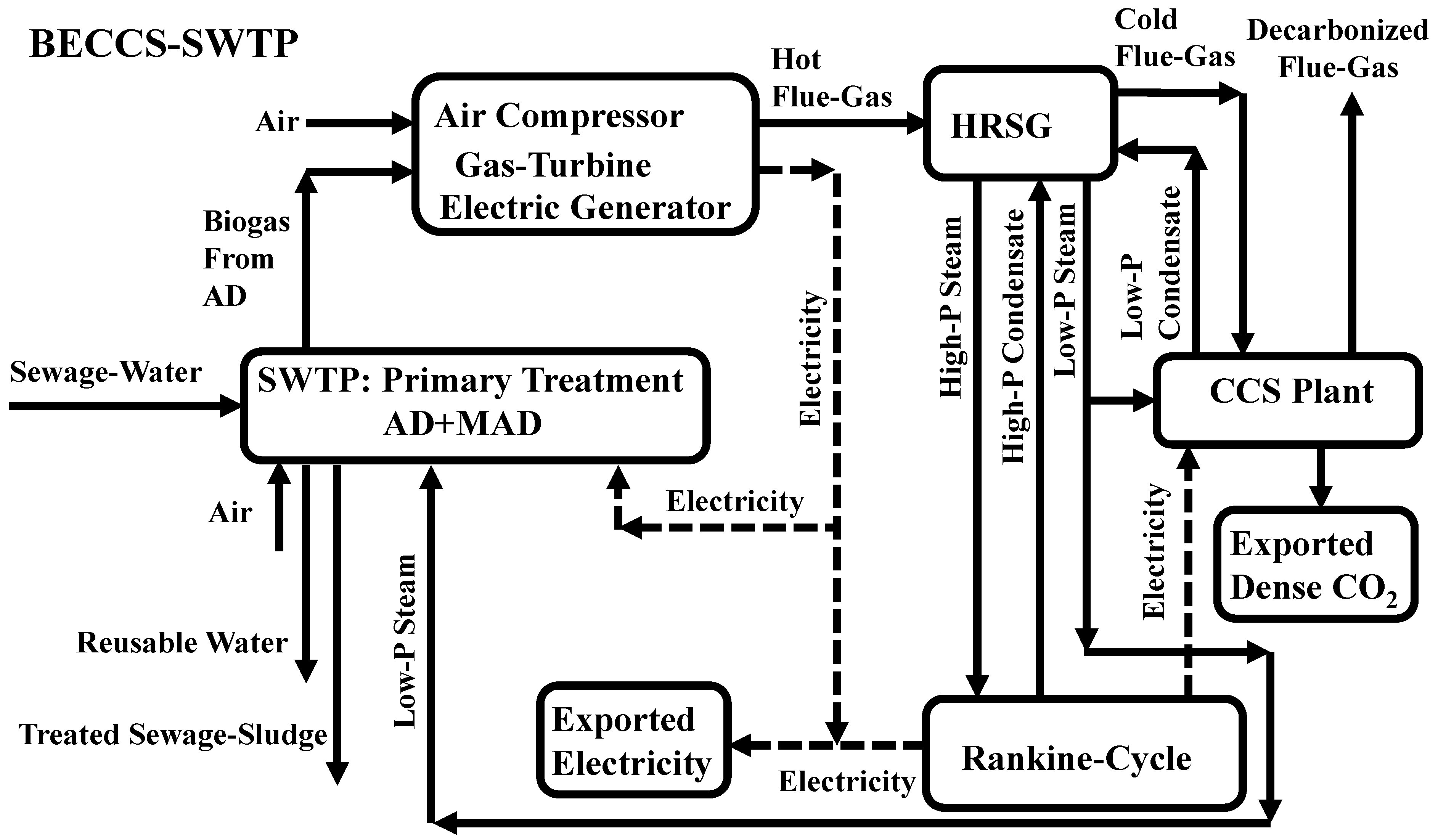Sewage-water treatment comprehends primary, secondary, and tertiary steps to produce reusable water after removing sewage contaminants. However, a sewage-water treatment plant is typically a power and energy consumer and produces high volumes of sewage sludge mainly generated in the primary and secondary steps. The use of more efficient anaerobic digestion of sewage water with sewage sludge can produce reasonable flowrates of biogas, which is shown to be a consolidated strategy towards the energy self-sufficiency and economic feasibility of sewage-water treatment plants. Anaerobic digestion can also reduce the carbon footprint of energy sources since the biogas produced can replace fossil fuels for electricity generation.
- sewage water
- anaerobic digestion
- biogas
- sewage-sludge treatment
- biogas combined cycle
- waste management
- BECCS
- CCS
- carbon capture
- negative emissions
1. Introduction
2. Power Generation in Sewage-Water Treatment Plants

2.1. Biogas Gas Turbine Cycles and Biogas Combined Cycles

2.2. Internal Combustion Engines
2.3. Integrated CHP Systems
2.3.1. Solid Oxide Fuel Cell
2.3.2. Photovoltaic Systems
3. Power Generation in Sewage-Water Treatment with Carbon Capture and Storage
References
- Gerba, C.P.; Pepper, I.L. Chapter 22—Municipal Wastewater Treatment. In Environmental and Pollution Science; Brusseau, M.L., Pepper, I.L., Gerba, C.P., Eds.; Academic Press: Cambridge, MA, USA, 2019; pp. 393–418. Shahabadi, M.B.; Yerushalmi, L.; Haghighat, F. Estimation of greenhouse gas generation in wastewater treatment plants—Model development and application. Chemosphere 2010, 78, 1085–1092.
- Appels, L.; Lauwers, J.; Degrève, J.; Helsen, L.; Lievens, B.; Willems, K.; Van Impe, J.; Dewil, R. Anaerobic digestion in global bio-energy production: Potential and research challenges. Renew. Sustain. Energy Rev. 2011, 15, 4295–4301. Orhon, D.; Germirli Babuna, F.; Karahan Özgün, Ö. Industrial Wastewater Treatment by Activated Sludge; IWA Publishing: London, UK, 2009.
- Aziz, A.; Basheer, F.; Sengar, A.; Irfanullah; Khan, S.U.; Farooqi, I.H. Biological wastewater treatment (anaerobic-aerobic) technologies for safe discharge of treated slaughterhouse and meat processing wastewater. Sci. Total Environ. 2019, 686, 681–708. Lee, S.; Esfahani, I.J.; Ifaei, P.; Moya, W.; Yoo, C. Thermo-environ-economic modeling and optimization of an integrated wastewater treatment plant with a combined heat and power generation system. Energy Convers. Manag. 2017, 142, 385–401.
- Schwarzenbeck, N.; Pfeiffer, W.; Bomball, E. Can a wastewater treatment plant be a powerplant? A case study. Water Sci. Technol. 2008, 57, 1555–1561.
- Singh, A.D.; Upadhyay, A.; Shrivastava, S.; Vivekanand, V. Life-cycle assessment of sewage sludge-based large-scale biogas plant. Bioresour. Technol. 2020, 309, 123373.
- Kamali, M.; Costa, M.E.; Aminabhavi, T.M.; Capela, I. Sustainability of treatment technologies for industrial biowastes effluents. Chem. Eng. J. 2019, 370, 1511–1521.
- Iglesias, R.; Muñoz, R.; Polanco, M.; Díaz, I.; Susmozas, A.; Moreno, A.; Guirado, M.; Carreras, N.; Ballesteros, M. Biogas from Anaerobic Digestion as an Energy Vector: Current Upgrading Development. Energies 2021, 14, 2742.
- Odirile, P.T.; Marumoloa, P.M.; Manali, A.; Gikas, P. Anaerobic Digestion for Biogas Production from Municipal Sewage Sludge: A Comparative Study between Fine Mesh Sieved Primary Sludge and Sedimented Primary Sludge. Water 2021, 13, 3532.
- Kiselev, A.; Magaril, E.; Magaril, R.; Panepinto, D.; Ravina, M.; Zanetti, M.C. Towards Circular Economy: Evaluation of Sewage Sludge Biogas Solutions. Resources 2019, 8, 91.
- Silvestre, G.; Fernández, B.; Bonmati, A. Significance of anaerobic digestion as a source of clean energy in wastewater treatment plants. Energy Convers. Manag. 2015, 101, 255–262.
- Udaeta, M.E.M.; de S. Medeiros, G.A.; da Silva, V.O.; Galvão, L.C.R. Basic and procedural requirements for energy potential from biogas of sewage treatment plants. J. Environ. Manag. 2019, 236, 380–387.
- Mensah, J.H.R.; Silva, A.T.Y.L.; dos Santos, I.F.S.; Ribeiro, N.D.S.; Gbedjinou, M.J.; Nago, V.G.; Tiago Filho, G.L.; Barros, R.M. Assessment of electricity generation from biogas in Benin from energy and economic viability perspectives. Renew. Energy 2020, 163, 613–624.
- Schaubroeck, T.; De Clippeleir, H.; Weissenbacher, N.; Dewulf, J.; Boeckx, P.; Vlaeminck, S.E.; Wett, B. Environmental sustainability of an energy self-sufficient sewage treatment plant: Improvements through DEMON and co-digestion. Water Res. 2015, 74, 166–179.
- Nowak, O.; Keil, S.; Fimml, C. Examples of energy self-sufficient municipal nutrient removal plants. Water Sci. Technol. 2011, 64, 1–6.
- Chen, Y.; Zhang, T.; Yang, H.; Peng, J. Study on energy and economic benefits of converting a combined heating and power system to a tri-generation system for sewage treatment plants in subtropical area. Appl. Therm. Eng. 2016, 94, 24–39.
- Sadhukhan, J. Distributed and micro-generation from biogas and agricultural application of sewage sludge: Comparative environmental performance analysis using life cycle approaches. Appl. Energy 2014, 122, 196–206.
- Siemens. Gas Turbine Portfolio—We Power the World with Innovative Gas Turbines. 2020. Available online: https://assets.new.siemens.com/siemens/assets/api/uuid:10f4860b140b2456f05d32629d8d758dc00bcc30/gas-turbines-siemens-interactive.pdf (accessed on 25 January 2022).
- Bin Basrawi, M.F.; Yamada, T.; Nakanishi, K.; Katsumata, H. Analysis of the performances of biogas-fuelled micro gas turbine cogeneration systems (MGT-CGSs) in middle- and small-scale sewage treatment plants: Comparison of performances and optimization of MGTs with various electrical power outputs. Energy 2012, 38, 291–304.
- Basrawi, F.; Ibrahim, T.K.; Habib, K.; Yamada, T.; Idris, D.M.N.D. Techno-economic performance of biogas-fueled micro gas turbine cogeneration systems in sewage treatment plants: Effect of prime mover generation capacity. Energy 2017, 124, 238–248.
- Chang, C.-C.; Do, M.V.; Hsu, W.-L.; Liu, B.-L.; Chang, C.-Y.; Chen, Y.-H.; Yuan, M.-H.; Lin, C.-F.; Yu, C.-P.; Chen, Y.-H.; et al. A Case Study on the Electricity Generation Using a Micro Gas Turbine Fuelled by Biogas from a Sewage Treatment Plant. Energies 2019, 12, 2424.
- Lee, S.; Esfahani, I.J.; Ifaei, P.; Moya, W.; Yoo, C. Thermo-environ-economic modeling and optimization of an integrated wastewater treatment plant with a combined heat and power generation system. Energy Convers. Manag. 2017, 142, 385–401.
- Poblete, I.B.S.; Araújo, O.D.Q.F.; de Medeiros, J.L. Sewage-water treatment with bio-energy production and carbon capture and storage. Chemosphere 2021, 286, 131763.
- Movahed, P.; Avami, A. Techno-economic optimization of biogas-fueled micro gas turbine cogeneration systems in sewage treatment plant. Energy Convers. Manag. 2020, 218, 112965.
- Mustafi, N.N.; Raine, R.R.; Bansal, P.K. The Use of Biogas in Internal Combustion Engines: A Review. In Proceedings of the ASME 2006 Internal Combustion Engine Division Spring Technical Conference, Aachen, Germany, 7–10 May 2006; pp. 225–234.
- Henham, A.; Makkar, M. Combustion of simulated biogas in a dual-fuel diesel engine. Energy Convers. Manag. 1998, 39, 2001–2009.
- Gómez, A.; Zubizarreta, J.; Rodrigues, M.; Dopazo, C.; Fueyo, N. Potential and cost of electricity generation from human and animal waste in Spain. Renew. Energy 2010, 35, 498–505.
- Di Fraia, S.; Figaj, R.D.; Massarotti, N.; Vanoli, L. An integrated system for sewage sludge drying through solar energy and a combined heat and power unit fuelled by biogas. Energy Convers. Manag. 2018, 171, 587–603.
- González-Arias, J.; Gil, M.V.; Fernández, R.; Martínez, E.J.; Fernández, C.; Papaharalabos, G.; Gómez, X. Integrating anaerobic digestion and pyrolysis for treating digestates derived from sewage sludge and fat wastes. Environ. Sci. Pollut. Res. 2020, 27, 32603–32614.
- Mills, N.; Pearce, P.; Farrow, J.; Thorpe, R.B.; Kirkby, N.F. Environmental & economic life cycle assessment of current & future sewage sludge to energy technologies. Waste Manag. 2013, 34, 185–195.
- Giarola, S.; Forte, O.; Lanzini, A.; Gandiglio, M.; Santarelli, M.; Hawkes, A. Techno-economic assessment of biogas-fed solid oxide fuel cell combined heat and power system at industrial scale. Appl. Energy 2018, 211, 689–704.
- Mehr, A.S.; MosayebNezhad, M.; Lanzini, A.; Yari, M.; Mahmoudi, S.M.S.; Santarelli, M. Thermodynamic assessment of a novel SOFC based CCHP system in a wastewater treatment plant. Energy 2018, 150, 299–309.
- Wang, Y.; Wehrle, L.; Banerjee, A.; Shi, Y.; Deutschmann, O. Analysis of a biogas-fed SOFC CHP system based on multi-scale hierarchical modeling. Renew. Energy 2020, 163, 78–87.
- Gretzschel, O.; Schäfer, M.; Steinmetz, H.; Pick, E.; Kanitz, K.; Krieger, S. Advanced Wastewater Treatment to Eliminate Organic Micropollutants in Wastewater Treatment Plants in Combination with Energy-Efficient Electrolysis at WWTP Mainz. Energies 2020, 13, 3599.
- Su, B.; Wang, Z.; Han, W.; Jin, H. Using solar energy to improve the energy performance of tri-generation systems for sewage treatment plants. Energy Procedia 2017, 142, 873–879.
- Jacob, R.; Short, M.; Belusko, M.; Bruno, F. Maximising renewable gas export opportunities at wastewater treatment plants through the integration of alternate energy generation and storage options. Sci. Total Environ. 2020, 742, 140580.
- Wei, L.; Zhu, F.; Li, Q.; Xue, C.; Xia, X.; Yu, H.; Zhao, Q.; Jiang, J.; Bai, S. Development, current state and future trends of sludge management in China: Based on exploratory data and CO2-equivaient emissions analysis. Environ. Int. 2020, 144, 106093.
- Fighir, D.; Teodosiu, C.; Fiore, S. Environmental and Energy Assessment of Municipal Wastewater Treatment Plants in Italy and Romania: A Comparative Study. Water 2019, 11, 1611.
- Shahabadi, M.B.; Yerushalmi, L.; Haghighat, F. Estimation of greenhouse gas generation in wastewater treatment plants—Model development and application. Chemosphere 2010, 78, 1085–1092.
- Buonocore, E.; Mellino, S.; De Angelis, G.; Liu, G.; Ulgiati, S. Life cycle assessment indicators of urban wastewater and sewage sludge treatment. Ecol. Indic. 2018, 94, 13–23.
- Borzooei, S.; Campo, G.; Cerutti, A.; Meucci, L.; Panepinto, D.; Ravina, M.; Riggio, V.; Ruffino, B.; Scibilia, G.; Zanetti, M. Feasibility analysis for reduction of carbon footprint in a wastewater treatment plant. J. Clean. Prod. 2020, 271, 122526.
- Keller, J.; Hartley, K. Greenhouse gas production in wastewater treatment: Process selection is the major factor. Water Sci. Technol. 2003, 47, 43–48.
- Niu, D.-J.; Huang, H.; Dai, X.-H.; Zhao, Y.-C. Greenhouse gases emissions accounting for typical sewage sludge digestion with energy utilization and residue land application in China. Waste Manag. 2013, 33, 123–128.
- Münster, M.; Lund, H. Use of waste for heat, electricity and transport—Challenges when performing energy system analysis. Energy 2009, 34, 636–644.
- Chernicharo, C.A.L.; Brandt, E.M.F.; Bressani-Ribeiro, T.; Melo, V.R.; Bianchetti, F.J.; MotaFilho, C.R.; McAdam, E. Development of a tool for improving the management of gaseous emissions in UASB-based sewage treatment plants. Water Pract. Technol. 2017, 12, 917–926.
- Maktabifard, M.; Zaborowska, E.; Makinia, J. Evaluating the effect of different operational strategies on the carbon footprint of wastewater treatment plants—Case studies from northern Poland. Water Sci. Technol. 2019, 79, 2211–2220.
- Campello, L.D.; Barros, R.M.; Filho, G.L.T.; dos Santos, I.F.S. Analysis of the economic viability of the use of biogas produced in wastewater treatment plants to generate electrical energy. Environ. Dev. Sustain. 2020, 23, 2614–2629.
- Rosa, L.; Sanchez, D.L.; Mazzotti, M. Assessment of carbon dioxide removal potential via BECCS in a carbon-neutral Europe. Energy Environ. Sci. 2021, 14, 3086–3097.
- Pour, N.; Webley, P.A.; Cook, P.J. Potential for using municipal solid waste as a resource for bioenergy with carbon capture and storage (BECCS). Int. J. Greenh. Gas Control 2018, 68, 1–15.
- Ziółkowski, P.; Badur, J.; Pawlak- Kruczek, H.; Stasiak, K.; Amiri, M.; Niedzwiecki, L.; Krochmalny, K.; Mularski, J.; Madejski, P.; Mikielewicz, D. Mathematical modelling of gasification process of sewage sludge in reactor of negative CO2 emission power plant. Energy 2021, 244, 122601.
- Lu, L.; Guest, J.S.; Peters, C.A.; Zhu, X.; Rau, G.H.; Ren, Z.J. Wastewater treatment for carbon capture and utilization. Nat. Sustain. 2018, 1, 750–758.
- Poblete, I.B.S.; Ofélia de Queiroz, F.A.; de Medeiros, J.L. Dynamic analysis of sustainable biogas-combined-cycle plant: Time-varying demand and bioenergy with carbon capture and storage. Renew. Sustain. Energy Rev. 2020, 131, 109997.
- Pandey, P.; Shinde, V.N.; Deopurkar, R.L.; Kale, S.P.; Patil, S.A.; Pant, D. Recent advances in the use of different substrates in microbial fuel cells toward wastewater treatment and simultaneous energy recovery. Appl. Energy 2016, 168, 706–723.
- Huang, Z.; Jiang, D.; Lu, L.; Ren, Z.J. Ambient CO2 capture and storage in bioelectrochemically mediated wastewater treatment. Bioresour. Technol. 2016, 215, 380–385.
- Lu, L.; Huang, Z.; Rau, G.H.; Ren, Z.J. Microbial Electrolytic Carbon Capture for Carbon Negative and Energy Positive Wastewater Treatment. Environ. Sci. Technol. 2015, 49, 8193–8201.
- Shin, H.J.; Jung, K.A.; Nam, C.W.; Park, J.M. A genetic approach for microbial electrosynthesis system as biocommodities production platform. Bioresour. Technol. 2017, 245, 1421–1429.
- Batlle-Vilanova, P.; Rovira-Alsina, L.; Puig, S.; Balaguer, M.D.; Icaran, P.; Monsalvo, V.M.; Rogalla, F.; Colprim, J. Biogas upgrading, CO2 valorisation and economic revaluation of bioelectrochemical systems through anodic chlorine production in the framework of wastewater treatment plants. Sci. Total Environ. 2019, 690, 352–360.
